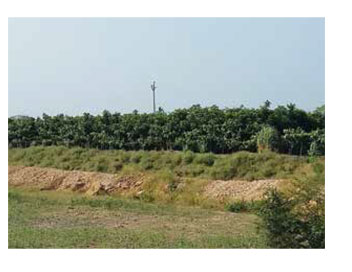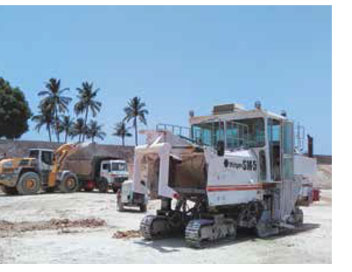Environment. Being future-ready.
Responsible Mining
Limestone is sourced through our captive mines in the vicinity of our integrated cement plants. Sustainable extraction and innovative operational practices at our mining sites balance environment protection and social well-being with long term economic growth. At Darlaghat, a seemingly impossible 3.5 km conveyor belt was installed in 1995 through three hills. This reduced the distance between the mine and the plant; it also protected the environment from road traffic and emissions. The limestone is excavated by highly mechanised, modern, open-cast mining technology which takes into account the geography and geology of the area, the occurrence of the deposit, the physical and chemical characteristics of the mineral, and the quantum of waste material or soil to be removed.
 A blast-free surface miner technique, suitable for soft
to moderately hard limestone, is used in Gujarat. It
replaces drilling, blasting and primary crushing with
zero ground vibration and minimal noise and dust.
At other mines, controlled blasting techniques are
employed using high precision electronic detonators
that improve blasting, minimise generation of fly rock,
reduce vibration, and are safe in extraneous electric
environments. Such detonators may also require a
smaller amount of explosive. The latest electronic
detonators are used at Bhatapara and Darlaghat.
There is practically no disturbance to the community.
At Bhatapara, a primary rock breaker (terminator
impact hammer), that can excavate up to a three metre
depth, is used to excavate limestone in areas nearer to
habitation. It generates very low vibration and noise.
Broken material can be fed directly to the crusher
through excavators and dumpers. Blasting is always
supervised by competent Ambuja Cement persons.
The ground vibration of each blast is measured and
the results compared with the permissible vibration
standards of the Directorate General of Mines Safety
(DGMS). These scientific mining technologies are
employed to ensure conservation of minerals.
A blast-free surface miner technique, suitable for soft
to moderately hard limestone, is used in Gujarat. It
replaces drilling, blasting and primary crushing with
zero ground vibration and minimal noise and dust.
At other mines, controlled blasting techniques are
employed using high precision electronic detonators
that improve blasting, minimise generation of fly rock,
reduce vibration, and are safe in extraneous electric
environments. Such detonators may also require a
smaller amount of explosive. The latest electronic
detonators are used at Bhatapara and Darlaghat.
There is practically no disturbance to the community.
At Bhatapara, a primary rock breaker (terminator
impact hammer), that can excavate up to a three metre
depth, is used to excavate limestone in areas nearer to
habitation. It generates very low vibration and noise.
Broken material can be fed directly to the crusher
through excavators and dumpers. Blasting is always
supervised by competent Ambuja Cement persons.
The ground vibration of each blast is measured and
the results compared with the permissible vibration
standards of the Directorate General of Mines Safety
(DGMS). These scientific mining technologies are
employed to ensure conservation of minerals.
Drilling is done with a drill having an in-built water sprinkler for dust suppression and a separate dust extraction system, making the technique practically dust-free. Haul roads within the mines are maintained with compactors and graders. They are regularly sprinkled with water to reduce fugitive dust emission. Limestone beneficiation and extraction techniques are used to ensure minimum waste.
Water harvesting from mined-out pits for the use of the Company and nearby communities and groundwater recharge at Ambuja Cement mines are our major sustainable development initiatives. At the Rabriyawas mine, a check dam has been constructed to channelize storm water for groundwater recharge.
The Bhatapara mine has installed two safety devices: an operators’ fatigue monitoring sensor installed in front of the operator, that monitors characteristics linked to fatigue; and a proximity sensor in heavy earth moving machinery (HEMM) and dumpers, that detects and sends a signal to the operator’s cabin about the presence of any other equipment within a 20 m radius. The latter is very useful in case of low visibility. A modular design fugitive dust suppression system checks fugitive dust on haul roads at the Maratha mine. It creates a mist of raw water called road fog that is sprayed through a mist gun with a radial throw of 30-40 metres to settle airborne dust. A washing arrangement for crawler-mounted equipment and fire-fighting gun make it a multipurpose vehicle. At Ambujanagar, a mechanical system for covered tippers has been developed in-house to eliminate spillage and dust emission, since the limestone is transported from the mine to the plant through a public road. Required health and safety measures are practiced in all our mines. GRI 413-2
None of our sites operates in the immediate vicinity of specific biodiversity zones. Biodiversity (flora and fauna) studies have been conducted by third parties for almost all mining areas. Ambuja Cements Ltd. follows the Group Biodiversity Directive that requires it to prepare a biodiversity action plan (BAP) for sensitive sites. This has been completed for Ambujanagar and Darlaghat where it is being implemented. MM2
In 2016, about 42,88,148 tonnes of overburden/ interburden or waste material was generated with no tailings or sludge. It was disposed of separately in non-mineralised zones through an excavator-dumperdozer combination as per the approved mine plan. The excavated soil is stored and utilised for pastureland development or plantation. The dumps are designed with a predefined slope angle for maximum stability. At Bhatapara and MCW, the slopes have been stabilised by coir matting and plantation. No associated risks have been identified so far.MM3
 Our operating sites are not located adjacent to
indigenous peoples’ territories. Local community issues
revolved around land acquisition and dust emission.
Concerns of the community are addressed through a
consultative process. ACF undertakes programmes
for community welfare and progress. We do not have
artisanal and small-scale mining sites. Land is purchased
through negotiations. Progressive mine closure plans
are available as per statute for all locations. Concurrent
rehabilitation plans are available for the working mines in Gujarat. There were no strikes or lockouts at our mines in
the reporting period. MM5 to MM10
Our operating sites are not located adjacent to
indigenous peoples’ territories. Local community issues
revolved around land acquisition and dust emission.
Concerns of the community are addressed through a
consultative process. ACF undertakes programmes
for community welfare and progress. We do not have
artisanal and small-scale mining sites. Land is purchased
through negotiations. Progressive mine closure plans
are available as per statute for all locations. Concurrent
rehabilitation plans are available for the working mines in Gujarat. There were no strikes or lockouts at our mines in
the reporting period. MM5 to MM10
Inconsistent limestone quality in the deposits, occurrence of non-calcareous bands within limestone and overburden increase the complexity of the deposits. Accurate evaluation becomes very important. Ambuja Cements Ltd. uses state-of-the-art computerbased long and short term planning tools to ensure a steady supply of raw materials. Blending material of different grades and qualities helps in maximising mine life and conserving natural resources, minimising waste generation and reducing environment management and mine closure costs. The techniques used in our mines include QuarryMaster software for better blending and pile planning; GIS-GPS techniques to control production levels; controlled blasting by I-Kon (E-det system) and PGNAA technology for online analysis of crushed ROM; PGNAA and screening plant for blending of sub-grade material; a primary rock breaker for excavation of thin band high grade limestone; a reverse camera system fitted in the dumpers; a rock breaker for first bench boulder formation; a backhoe (excavator) for below-water level limestone excavation; a terminator to break the material near a village boundary; and mineral conservation through a wobbler and screen plant. MM11